基于CFD的圆柱形喷嘴设计
- 格式:pdf
- 大小:231.98 KB
- 文档页数:3
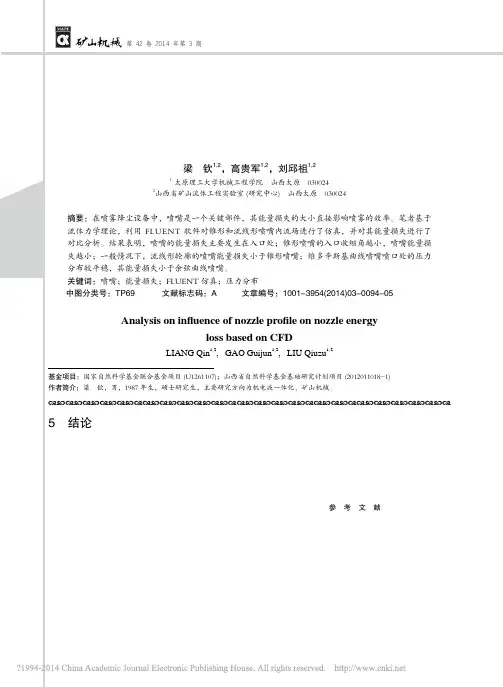
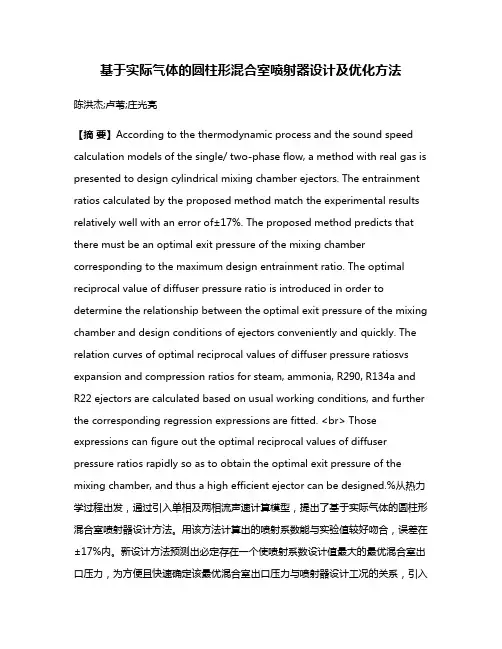
基于实际气体的圆柱形混合室喷射器设计及优化方法陈洪杰;卢苇;庄光亮【摘要】According to the thermodynamic process and the sound speed calculation models of the single/ two-phase flow, a method with real gas is presented to design cylindrical mixing chamber ejectors. The entrainment ratios calculated by the proposed method match the experimental results relatively well with an error of±17%. The proposed method predicts that there must be an optimal exit pressure of the mixing chamber corresponding to the maximum design entrainment ratio. The optimal reciprocal value of diffuser pressure ratio is introduced in order to determine the relationship between the optimal exit pressure of the mixing chamber and design conditions of ejectors conveniently and quickly. The relation curves of optimal reciprocal values of diffuser pressure ratiosvs expansion and compression ratios for steam, ammonia, R290, R134a and R22 ejectors are calculated based on usual working conditions, and further the corresponding regression expressions are fitted. <br> Those expressions can figure out the optimal reciprocal values of diffuser pressure ratios rapidly so as to obtain the optimal exit pressure of the mixing chamber, and thus a high efficient ejector can be designed.%从热力学过程出发,通过引入单相及两相流声速计算模型,提出了基于实际气体的圆柱形混合室喷射器设计方法。

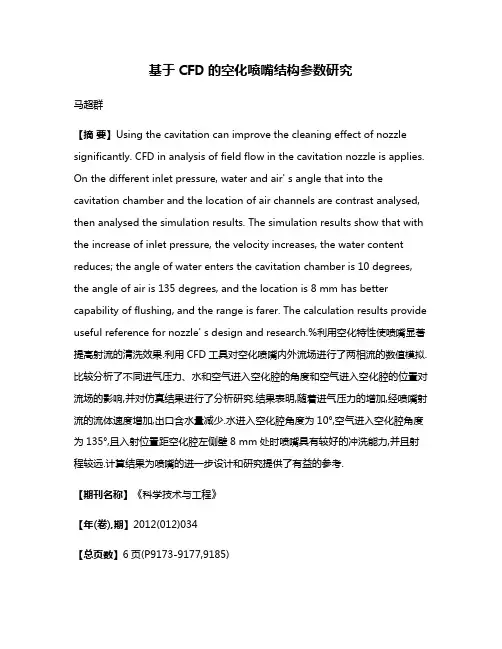
基于CFD的空化喷嘴结构参数研究马超群【摘要】Using the cavitation can improve the cleaning effect of nozzle significantly. CFD in analysis of field flow in the cavitation nozzle is applies. On the different inlet pressure, water and air' s angle that into the cavitation chamber and the location of air channels are contrast analysed, then analysed the simulation results. The simulation results show that with the increase of inlet pressure, the velocity increases, the water content reduces; the angle of water enters the cavitation chamber is 10 degrees, the angle of air is 135 degrees, and the location is 8 mm has better capability of flushing, and the range is farer. The calculation results provide useful reference for nozzle' s design and research.%利用空化特性使喷嘴显著提高射流的清洗效果.利用CFD工具对空化喷嘴内外流场进行了两相流的数值模拟.比较分析了不同进气压力、水和空气进入空化腔的角度和空气进入空化腔的位置对流场的影响,并对仿真结果进行了分析研究.结果表明,随着进气压力的增加,经喷嘴射流的流体速度增加,出口含水量减少.水进入空化腔角度为10°,空气进入空化腔角度为135°,且入射位置距空化腔左侧壁8 mm处时喷嘴具有较好的冲洗能力,并且射程较远.计算结果为喷嘴的进一步设计和研究提供了有益的参考.【期刊名称】《科学技术与工程》【年(卷),期】2012(012)034【总页数】6页(P9173-9177,9185)【关键词】空化喷嘴;动压;入射倾角;射程【作者】马超群【作者单位】北京铁路局供电处北京100860【正文语种】中文【中图分类】TH137.9喷嘴作为流体射流的发生元件,它不仅要把水的压力能转换为动能,更要保证射出的流体具有优良的流动特性和动力特性[1],从而达到清洗绝缘子的效果。
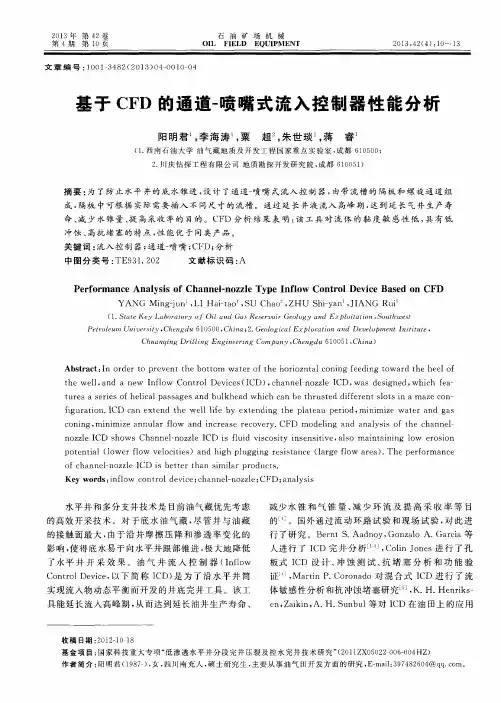
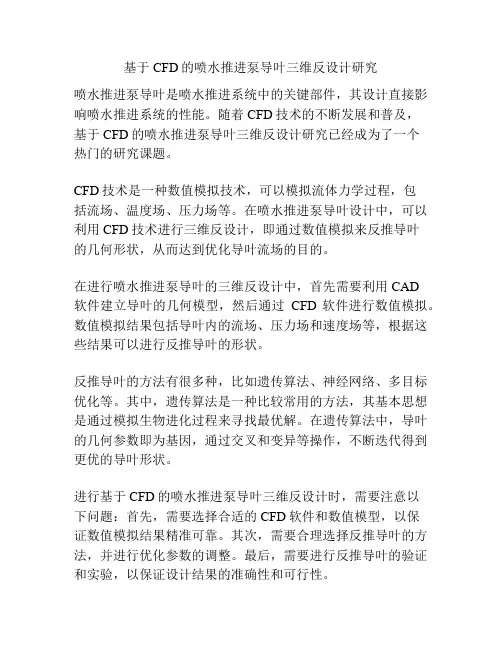
基于CFD的喷水推进泵导叶三维反设计研究喷水推进泵导叶是喷水推进系统中的关键部件,其设计直接影响喷水推进系统的性能。
随着CFD技术的不断发展和普及,基于CFD的喷水推进泵导叶三维反设计研究已经成为了一个热门的研究课题。
CFD技术是一种数值模拟技术,可以模拟流体力学过程,包括流场、温度场、压力场等。
在喷水推进泵导叶设计中,可以利用CFD技术进行三维反设计,即通过数值模拟来反推导叶的几何形状,从而达到优化导叶流场的目的。
在进行喷水推进泵导叶的三维反设计中,首先需要利用CAD软件建立导叶的几何模型,然后通过CFD软件进行数值模拟。
数值模拟结果包括导叶内的流场、压力场和速度场等,根据这些结果可以进行反推导叶的形状。
反推导叶的方法有很多种,比如遗传算法、神经网络、多目标优化等。
其中,遗传算法是一种比较常用的方法,其基本思想是通过模拟生物进化过程来寻找最优解。
在遗传算法中,导叶的几何参数即为基因,通过交叉和变异等操作,不断迭代得到更优的导叶形状。
进行基于CFD的喷水推进泵导叶三维反设计时,需要注意以下问题:首先,需要选择合适的CFD软件和数值模型,以保证数值模拟结果精准可靠。
其次,需要合理选择反推导叶的方法,并进行优化参数的调整。
最后,需要进行反推导叶的验证和实验,以保证设计结果的准确性和可行性。
总之,基于CFD的喷水推进泵导叶三维反设计研究是一个充满挑战的课题,需要研究者充分利用CFD技术,挖掘导叶优化的潜力,不断完善设计方法,推进喷水推进系统的发展。
数据分析是在统计的基础上对数据进行收集、整理、组织、解释和展示的过程,它是数据处理和挖掘的重要工具。
在现代社会,数据分析越来越成为各种领域中不可或缺的技能。
本文将列出几个案例中可能涉及的数据及其分析。
案例一:电商平台用户购物行为数据:用户的购物记录、订单数据、成交金额、订单号和用户ID等信息。
分析:首先要了解用户的购买行为,即用户在评论、浏览、搜索、购买商品的行为特征。
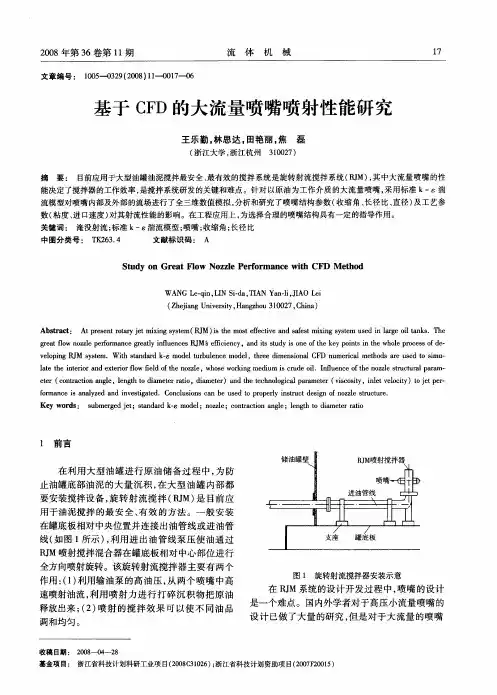
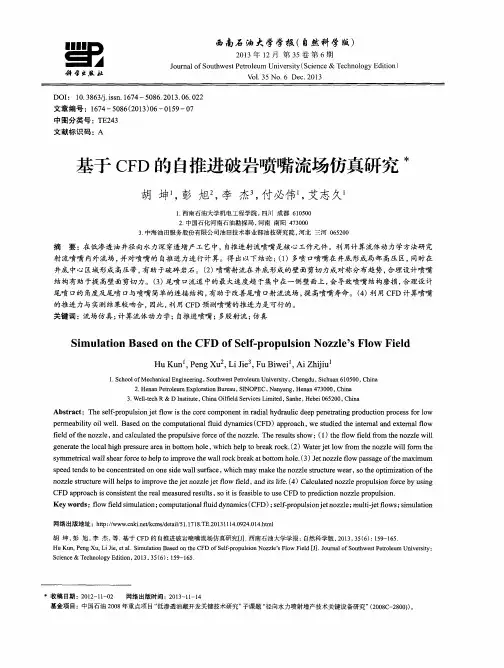
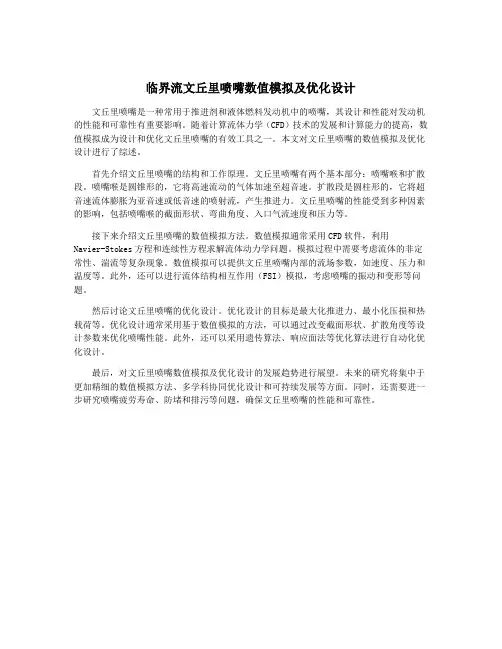
临界流文丘里喷嘴数值模拟及优化设计文丘里喷嘴是一种常用于推进剂和液体燃料发动机中的喷嘴,其设计和性能对发动机的性能和可靠性有重要影响。
随着计算流体力学(CFD)技术的发展和计算能力的提高,数值模拟成为设计和优化文丘里喷嘴的有效工具之一。
本文对文丘里喷嘴的数值模拟及优化设计进行了综述。
首先介绍文丘里喷嘴的结构和工作原理。
文丘里喷嘴有两个基本部分:喷嘴喉和扩散段。
喷嘴喉是圆锥形的,它将高速流动的气体加速至超音速。
扩散段是圆柱形的,它将超音速流体膨胀为亚音速或低音速的喷射流,产生推进力。
文丘里喷嘴的性能受到多种因素的影响,包括喷嘴喉的截面形状、弯曲角度、入口气流速度和压力等。
接下来介绍文丘里喷嘴的数值模拟方法。
数值模拟通常采用CFD软件,利用Navier-Stokes方程和连续性方程求解流体动力学问题。
模拟过程中需要考虑流体的非定常性、湍流等复杂现象。
数值模拟可以提供文丘里喷嘴内部的流场参数,如速度、压力和温度等。
此外,还可以进行流体结构相互作用(FSI)模拟,考虑喷嘴的振动和变形等问题。
然后讨论文丘里喷嘴的优化设计。
优化设计的目标是最大化推进力、最小化压损和热载荷等。
优化设计通常采用基于数值模拟的方法,可以通过改变截面形状、扩散角度等设计参数来优化喷嘴性能。
此外,还可以采用遗传算法、响应面法等优化算法进行自动化优化设计。
最后,对文丘里喷嘴数值模拟及优化设计的发展趋势进行展望。
未来的研究将集中于更加精细的数值模拟方法、多学科协同优化设计和可持续发展等方面。
同时,还需要进一步研究喷嘴疲劳寿命、防堵和排污等问题,确保文丘里喷嘴的性能和可靠性。

喷嘴CFD问题描述:当密度为ρ=1 kg/ m3,粘性系数为µ= 2×10-3 kg/(ms)的流体流过一个直径为D=0.2 m ,长度为L=8 m圆柱体时,入口速度为V Inlet=1m/s,流体在出口流入标准大气压的空气中(1 atm)。
流体的雷诺系数为:式中V avg表示流体在入口平均速度,此处为1m/s。
要求:1、利用Fluent解决这个问题。
2、画出喷嘴中心线处速度图,壁处的摩擦系数图以及出口处的速度轮廓图。
步骤1:利用Gambit建立几何模型1.1选择解算器Main Menu > Solver > Fluent 5/6(利用FLUENT 5/6解算器),可以假定流体是对称的,因此可以在如下范围内解决问题:式中,r和x分别是直径和轴线方向的坐标。
1.2建立几何模型的策略如图1-1所示建立模型(采用的是二维模型)。
为了建立长方形,必须先建立四个顶点,然后再建立四条边,最后组成长方形。
图1-1利用以下命令按钮建立顶点:Operation Toolpad > Geometry Command Button> Vertex Command Button > Create Vertex然后再如图所示的对话框中依次填入四个顶点的坐标,然后点击Apply即可:Vertex 1: (0,0,0)Vertex 2: (0,0.1,0)Vertex 3: (8,0.1,0)Vertex 4: (8,0,0)为了让图形更适宜观看,可以利用以下按钮:Operation Toolpad > Global Control >Fit to Window Button ,如图1-2所示:四个顶点如图1-3所示:图1-2图1-31.3 建立四条边在Gambit中选择任何实体(点、线、面),按住Shift 键,然后用鼠标点击需要选择的实体即可。
建立四条边所用到的按钮为:Operation Toolpad > Geometry Command Button > Edge Command Button> Create Edge先点击上面的按钮,然后选择两个顶点,在点击面板中Apply就可以建立一条边;依次建立四条边。
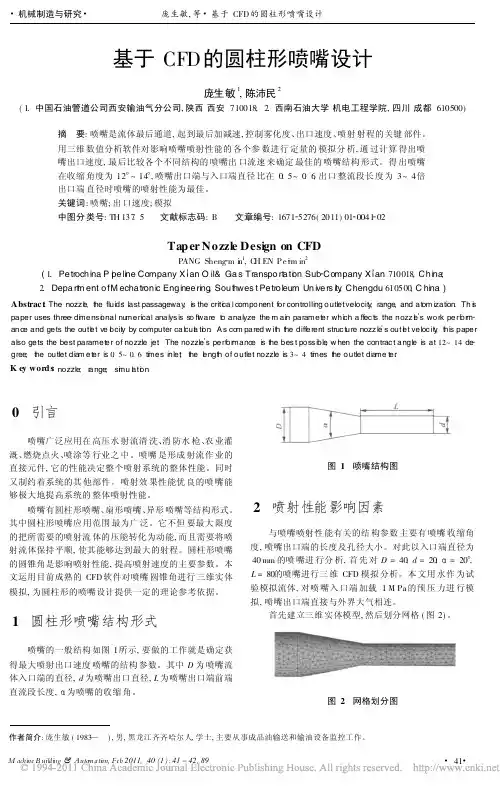
Machine B uildingAuto mation,Feb 2011,40(1):41-42,89作者简介:庞生敏(1983 ),男,黑龙江齐齐哈尔人,学士,主要从事成品油输送和输油设备监控工作。
基于CFD 的圆柱形喷嘴设计庞生敏1,陈沛民2(1.中国石油管道公司西安输油气分公司,陕西西安710018;2.西南石油大学机电工程学院,四川成都610500)摘 要:喷嘴是流体最后通道,起到最后加减速,控制雾化度、出口速度、喷射射程的关键部件。
用三维数值分析软件对影响喷嘴喷射性能的各个参数进行定量的模拟分析,通过计算得出喷嘴出口速度,最后比较各个不同结构的喷嘴出口流速来确定最佳的喷嘴结构形式。
得出喷嘴在收缩角度为12!~14!,喷嘴出口端与入口端直径比在0.5~0.6,出口整流段长度为3~4倍出口端直径时喷嘴的喷射性能为最佳。
关键词:喷嘴;出口速度;模拟中图分类号:TH 137.5 文献标志码:B 文章编号:1671 5276(2011)01 0041 02Taper Nozzle Design on CFDPANG Sheng m i n 1,C H EN P e i m in 2(1.Pe troch ina P i p e line Company X i an O il&Ga s Transpo rt a ti o n Sub Company X i an 710018,Ch ina ;2.Depa rt m ent o fM echa tron ic Eng inee ring ,Sou t hwes t Pe tro leum Un ive rs ity ,Chengdu 610500,C hina )Abstrac t :The nozz l e ,t he fluid 's last passageway ,is the criti c a l component f or controlling outletvelocit y ,range ,and at om ization .Th i spaper uses three dm i ens i o nal nu merical analys is so ft w are t o analyze the m ain paramet er which a ff ec t s the nozz l e s work perf or m ance and gets the outl e t ve l o cit y by computer calcul a ti o n .As co m pared w it h t he diff erent struc t ure nozz le s outl e t veloc it y ,t his paper also gets the best paramet er of nozzle je.t The nozzle s perf or mance is t he bes t poss ible ,w hen the contrac t angle is at 12~14de gree ;t he outlet dia m et er is 0.5~0.6tm i es inle;t t he l e ngt h of outlet nozzle is 3~4tm i es t he outlet dia me t er .K ey word s :nozzle ;r ange ;sm i u l a ti o n0 引言喷嘴广泛应用在高压水射流清洗、消防水枪、农业灌溉、燃烧点火、喷涂等行业之中。
基于CFD的喷气织机辅助喷嘴流场分析谭保辉;冯志华;刘丁丁;唐银萍【摘要】To analyze the characteristics of the flow field of the auxiliary nozzle, a 3-D model of the auxiliary nozzle is developed, and the analysis software Fluent based on computational fluid dynamics ( CFD) is used to digitally simulate the 3-D flow field of the auxiliary nozzle of an air-jet loom. The speed distribution curve and the pressure distribution curve on the central line of the actual flow speed at the exit of the auxiliary nozzle when the supple air pressure is 0. 28 MPa are obtained, along with the speed distribution at the exit of the nozzle under different supple air pressures. The results of computation show that when the supple air pressure is 0. 28 MPa, the maximum flow speed is 404 m/s at the nozzle exit where a negative pressure region is formed; and the flow speed at the nozzle exit increases gradually with the increase of the supple air pressure, which is increased by about 50 m/s for each 0. 1 MPa increment of supply air pressure. The comparison with experimental results of related documents shows that the numerical simulated results are in good agreement with the experimental ones of the flow field.%为研究辅助喷嘴的流场性质,建立喷气织机辅助喷嘴流场的三维模型,利用计算流体动力学(CFD)分析软件Fluent对辅助喷嘴流场的三维模型进行数值模拟,得到供气压力为0.28 MPa 条件下辅助喷嘴出口实际流速中心线上的速度分布曲线、压力分布曲线以及不同供气压力条件下辅助喷嘴出口的速度分布曲线.计算结果表明:供气压力为0.28 MPa 时,辅助喷嘴出口最大风速达404m/s,在辅助喷嘴出口出现了负压区;随着供气压力的增大,辅助喷嘴出口风速逐渐增大,供气压力每增加0.10 MPa,出口风速约增加50 m/s.通过与相关文献实验值的比较,证明了数值模拟方法和实验方法分析辅助喷嘴流场的一致性.【期刊名称】《纺织学报》【年(卷),期】2012(033)007【总页数】6页(P123-128)【关键词】喷气织机;辅助喷嘴;CFD;Fluent;流场【作者】谭保辉;冯志华;刘丁丁;唐银萍【作者单位】苏州大学机电工程学院,江苏苏州 215021;苏州大学现代丝绸国家工程实验室,江苏苏州 215021;苏州大学机电工程学院,江苏苏州 215021;苏州大学现代丝绸国家工程实验室,江苏苏州 215021;苏州大学机电工程学院,江苏苏州215021;苏州大学机电工程学院,江苏苏州 215021【正文语种】中文【中图分类】TS101.2由主喷嘴+辅助喷嘴+异型筘组成的气流引纬方式是喷气织机主要的引纬方式,在引纬过程中,辅助喷嘴担负着将纬纱接力送过梭口的重要任务;而辅助喷嘴的气耗量在正常引纬时占整机耗气量的75%左右,所以,为了提高生产率,降低能耗,研究辅助喷嘴的流场性质具有重要意义[1]。
ABSTRACTThe sediment incipience, transport and local scour in the case of complex flows are the hot research topic in river and coastal engineering all the time. The traditional theory in which only the mean bed shear stress or sediment carrying capacity formula is considered to study sediment transport and scour is not suitable in the case of complex flows containing turbulence and large-scale vortices. With the rapid development of discrete element method, it has developed fast to use numerical model to investigate this problem from the mesoscale view, which may reveal the mechnasim of sediment motion in the case of complex flows. Using computational fluid dynamics software OpenFOAM and particle motion simulation software LIGGGHTS, a coupled fluid-particle model, in which the flow field is simulated by LES model, is presented and applied in the investigation of sediment incipience, transport and local scour.The main contents and results of this thesis are as follows.(1) The characteristics of the flow around the cylinder are studied through the dynamic one-equation LES model, the velocity profile, leeward of the cylinder and the pressure distribution are analyzed. The simulated results are verified by comparion between RNGκε-numerical results and experimental results. The simulation results show that the dynamic one-equation LES model can describe the complex flows around cylinder and the pressure distribution better.(2) The coupled fluid-particle model is applied in the investigation of three dimensional turbulence, sediment incipience and the sediment transport at the downstream of the backward-facing step flow. The model describes the mean velocity profile, the turbulence intensity and the distribution of Reynold stress well. The probabilitv of sediment incipience and the sediment flux obtained by the coupled model at the downstream of the backward-facing step agree well with the experiment. The results indicate that the turbulence and large-scale vortices induce the sediment incipience and the mean flow contributes to its transport in the case of complex flows.(3) The coupled fluid-particle model is used to verify the sediment motion and simulate the scour around the cylinder, and the scour process and depth are analyzed. The variation of flow velocity, turbulent kinetic energy and vorticity developmentduring scouring are studied. The results reveal that the horseshoe vortex and the accelerating flow contribute dominantly to local scour in front of the cylinder while the turbulent fluctuation and wake vortex results in the scour developmentbehind the cylinder.KEY WORDS:CFD-DEM coupling model, Dynamic one-equation LES model, Complex flows, Sediment transport, Local scour目录摘要 (I)ABSTRACT (II)目录 (IV)第1章绪论 (1)1.1 研究背景与意义 (1)1.2 国内外研究现状 (2)1.2.1 圆柱绕流问题研究 (2)1.2.2 泥沙输运及冲刷问题研究 (3)1.2.3 DEM在颗粒流体耦合运动中的应用 (5)1.3 本文主要研究内容 (7)第2章CFD-DEM耦合模型 (8)2.1 流体控制方程及紊流模型 (8)2.1.1 流体控制方程 (8)2.1.2 紊流模型 (8)2.1.3 数值离散方法 (10)2.2 颗粒运动数学模型 (11)2.2.1 运动控制方程 (11)2.2.2 接触模型 (12)2.2.3 计算时间步长 (14)2.3 CFD-DEM耦合模型 (15)2.3.1 耦合模型控制方程 (15)2.3.2 流体颗粒相互作用力 (16)2.3.3 耦合计算过程 (18)2.4 本章小结 (18)第3章三维水流模型验证 (19)3.1 模型设置 (19)3.1.1 算例设计及边界条件 (19)3.1.2 明渠流模拟 (20)3.2 流场结果验证及分析 (21)3.3 压力结果验证及分析 (32)3.4 本章小结 (34)第4章复杂流动下的泥沙运动模拟研究 (35)4.1 后台阶流场模拟 (35)4.1.1 时均流速剖面验证 (36)4.1.2 紊动强度及雷诺应力验证 (37)4.2 泥沙起动概率验证 (38)4.2.1 模型设置 (38)4.2.2 结果验证及分析 (39)4.3 泥沙输运模拟研究 (42)4.3.1 算例设置 (42)4.3.2 结果分析 (43)4.4 本章小结 (45)第5章圆柱周围局部冲刷模拟研究 (47)5.1 模型设置及验证 (47)5.2 局部冲刷数值模拟 (50)5.2.1 算例设置 (50)5.2.2 冲刷过程随时间变化 (51)5.2.3 冲刷坑深度分析 (52)5.3 冲刷过程流动特性变化 (53)5.3.1 流速分布变化 (53)5.3.2 紊动能变化 (58)5.3.3 涡量场变化 (60)5.3.4 局部冲刷机制分析 (61)5.4 本章小结 (62)第6章结论与展望 (63)6.1 本文主要结论 (63)6.2 工作展望 (64)参考文献 (65)发表论文和参加科研情况说明 (72)致谢 (73)第1章绪论1.1研究背景与意义水工结构物如桥墩、桩柱等处在易受侵蚀床面上时,在水流持续作用下,其周围的水流流动呈现出强烈的紊动特征,并将改变周围床面的泥沙输运能力,从而引起建筑物周围局部地形变化即“局部冲刷”。